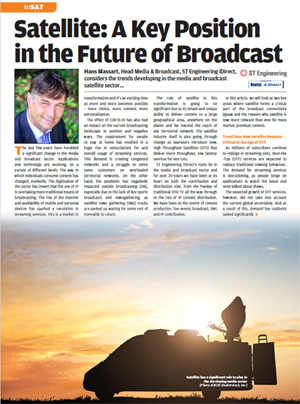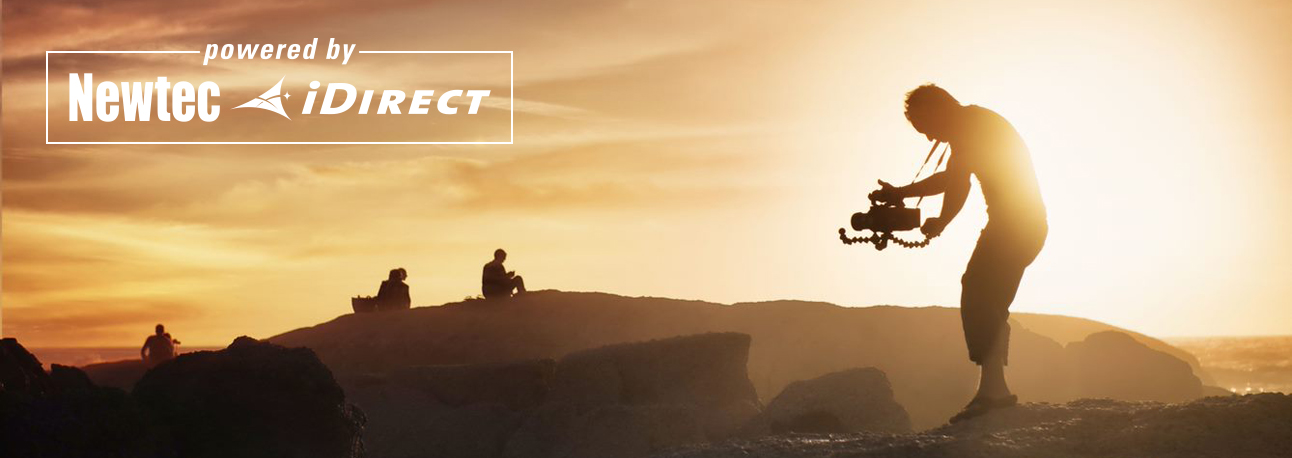By Hans Massart, Head Media & Broadcast, ST Engineering iDirect
 The last few years have heralded a significant change in the media and broadcast sector. Applications and technology are evolving, on a variety of different levels. The way in which individuals consume content has changed, markedly. The digitization of the sector has meant that the use of IP is overtaking more traditional means of broadcasting. The rise of the Internet and availability of mobile and personal devices has sparked a revolution in streaming services. This is a market in transformation and it’s an exciting time as more and more becomes possible – more choice, more content, more personalization.
The last few years have heralded a significant change in the media and broadcast sector. Applications and technology are evolving, on a variety of different levels. The way in which individuals consume content has changed, markedly. The digitization of the sector has meant that the use of IP is overtaking more traditional means of broadcasting. The rise of the Internet and availability of mobile and personal devices has sparked a revolution in streaming services. This is a market in transformation and it’s an exciting time as more and more becomes possible – more choice, more content, more personalization.
The effect of COVID-19 has also had an impact on the current broadcasting landscape in positive and negative ways. The requirement for people to stay at home has resulted in a huge rise in subscriptions for and overall usage of streaming services. This demand is creating congested networks and a struggle to serve some customers on overloaded terrestrial networks. On the other hand, the pandemic has negatively impacted outside broadcasting (OB), especially due to the lack of live sports broadcasts and newsgathering, as SNG trucks are parked up waiting for some sort of normality to return.
The role of satellite in this transformation is going to be significant due to its innate and unique ability to deliver content to a large geographical area, anywhere on the planet and far beyond the reach of any terrestrial network.
Let’s take a look at two key areas where satellite forms a critical part of the broadcast connectivity jigsaw and the reasons why satellite is now more relevant than ever for mass market, premium content.
Trend One: How satellite remains critical in the age of OTT
As millions of subscribers continue to indulge in streaming sites, Over the Top (OTT) services are expected to replace traditional viewing behavior. The demand for streaming services is skyrocketing, as people binge on applications to watch the latest and most talked about shows on various devices.
The question for broadcasters is how can they meet this demand both in the short and long term? Previously, satellite wasn’t thought to be compatible with OTT services – but it actually has a critical role to play as we move towards the future of content delivery – the OTT era.
Satellite transmission is the ideal solution for keeping costs under control, which is something operators and service providers have historically struggled with. Satellite’s ability to multicast is unrivalled and it is integral to successful content distribution.
The attractive price point of satellite transmission is just one advantage it brings, with the capability to multicast as one of the main drivers. Another benefit is that the technology can also deliver content efficiently over a vast geographical area. It can be cost-effectively scaled to a growing population of receivers and can be easily scaled to address more content.
Satellite is constantly developing and evolving, as we sit on the cusp of the 5G era, making it the perfect solution to provide streaming services and ultimately, remains critical in the age of OTT, whether we are challenged by a global pandemic or not.
Trend Two: All-IP Newsgathering
Another major trend with satellite at its core is All-IP Newsgathering. At the moment, live broadcasts are suspended, but sport and events will come back. The OB or SNG truck has become increasingly sophisticated as time has moved on, enabling broadcasters and news agencies to get to the scene rapidly, to set up and start broadcasting within minutes and to deliver their broadcast back to the studio via a contribution link.
A mix of technologies are employed to cover live events over a multiservice communications link. Today, a simple contribution link to relay the OB pictures back to headquarters is not enough. OB operators also require access to phone lines, the Internet, email and file transfer services. However, installation of these essential services is normally provided by fixed line operators and is very costly. Once the installation is completed, the services are often used on a one-time basis and very rarely used again. Installation of these critical services on board OB trucks eliminates the need for one-off installations and means that the services travel with the trucks wherever they are required.
Broadcasters need a flexible and adaptable satellite bandwidth management system which can send IP traffic over satellite as efficiently as possible.
During the Copa America football event last year, Casablanca Online, a leading Brazilian SNG and service provider, sought a reliable and cost-effective solution. Powered by our Newtec Dialog®, SES’ OU Flex solution provided IP connectivity to broadcasters’ outdoor production teams at the Morumbi Stadium São Paulo where a Copa America game was held between Chile and Peru. Combining live video transmission and IP connectivity via satellite, the OU Flex enabled both data and video applications for Occasional Use (OU) services.
All-IP newsgathering provides a very flexible solution that enables reliable broadcasts and reduces overall costs. Scalability in geography and volume is also enabled by the IP-based transmission, creating endless options for content distribution across the globe.
Time to Bust the Myths
Satellite is too often overlooked in the broadcast world, as many still consider it an expensive option and perhaps even consider it latent, but it is time to start busting some of these myths. Satellite is a huge asset to any broadcaster’s portfolio and it has an enormously bright future in the sector. Where terrestrial networks become congested, satellite steps in. Where terrestrial networks cannot reach, satellite can. Where the ability to multicast is not available, satellite prevails. Where terrestrial connectivity is not available, satellite provides the infrastructure no matter where it’s needed.
The media landscape may be evolving, but satellite has the agility to move with it – anywhere.
Learn about the transformation of the sector on our media and broadcast page.
